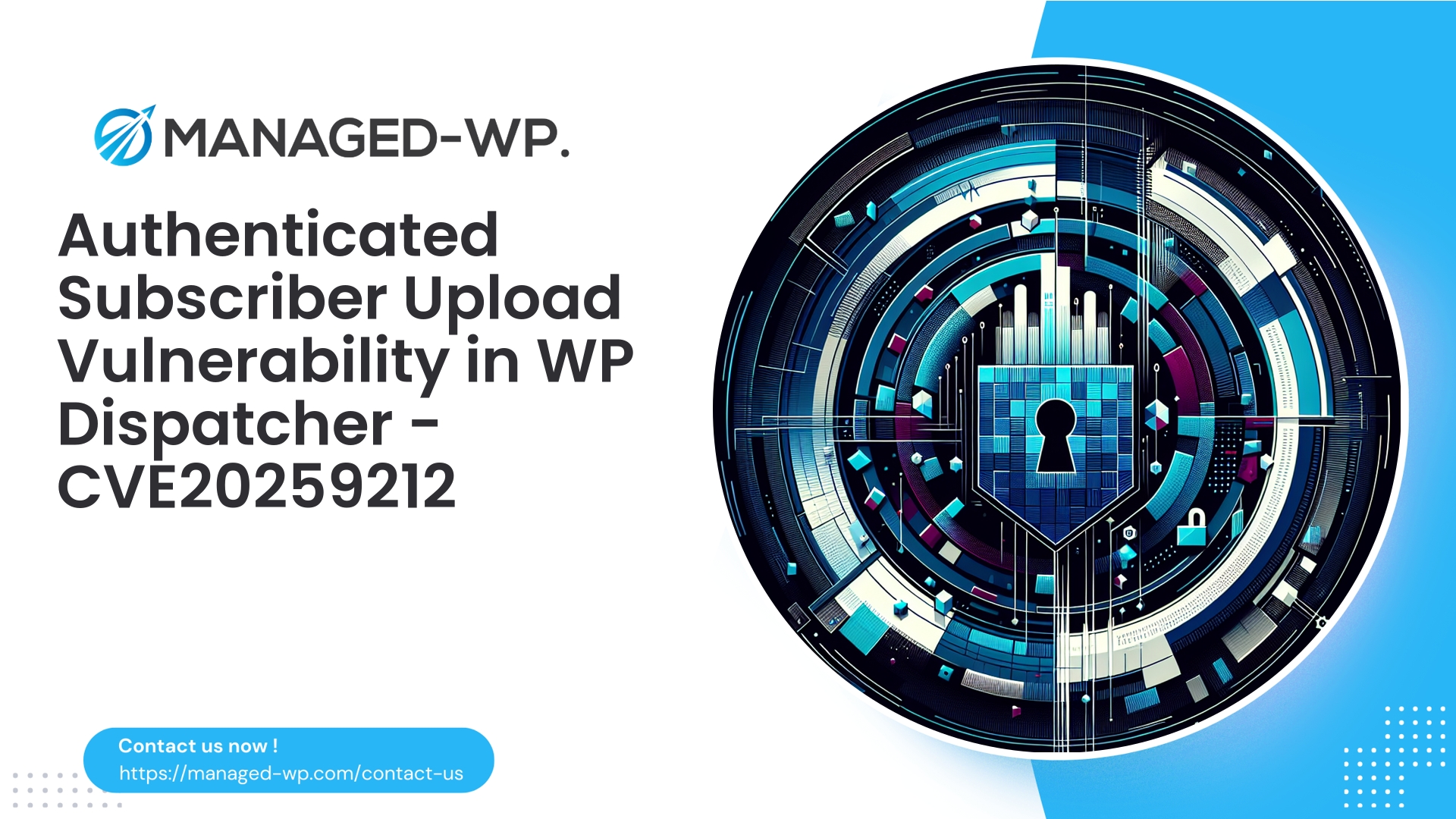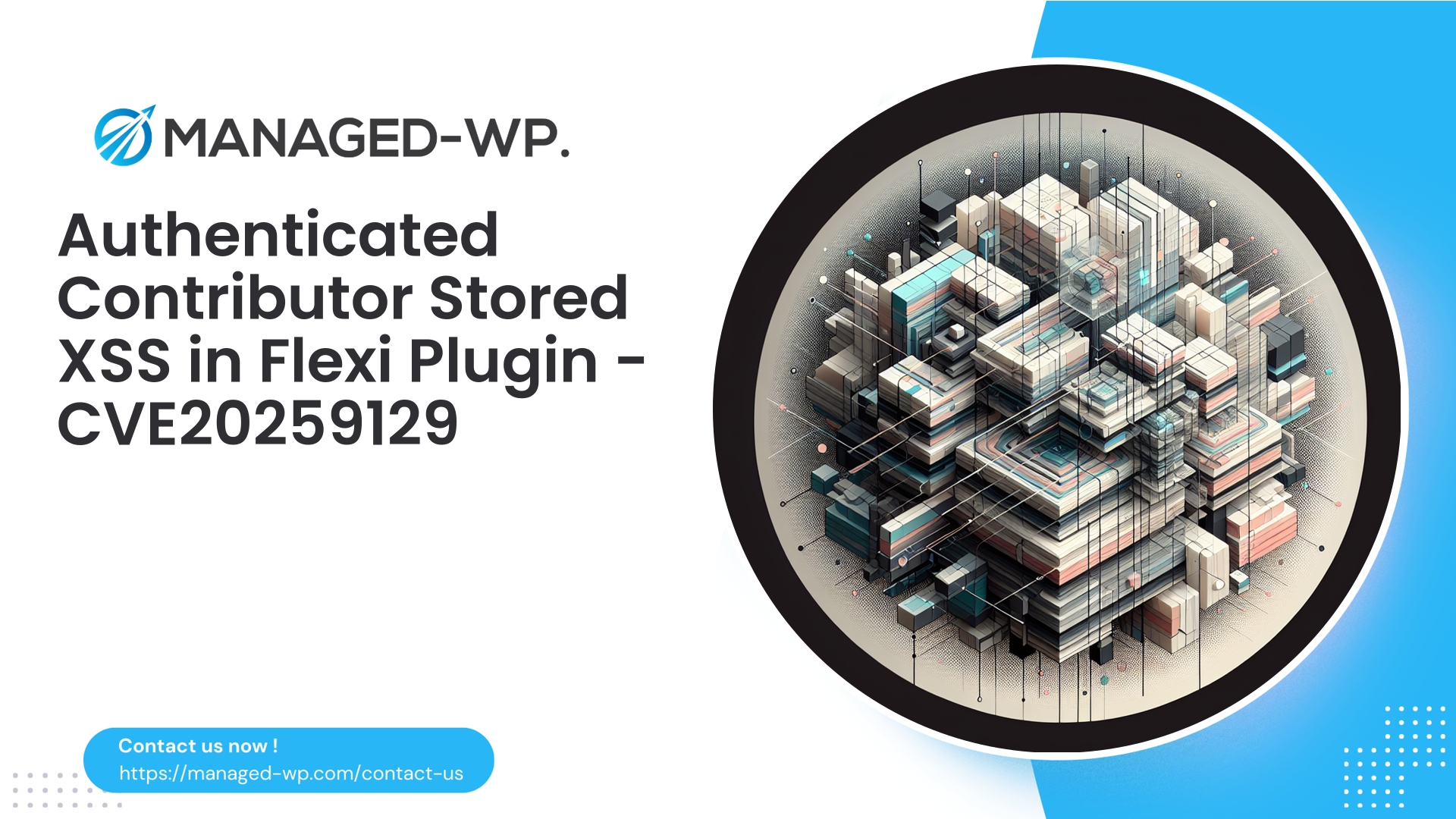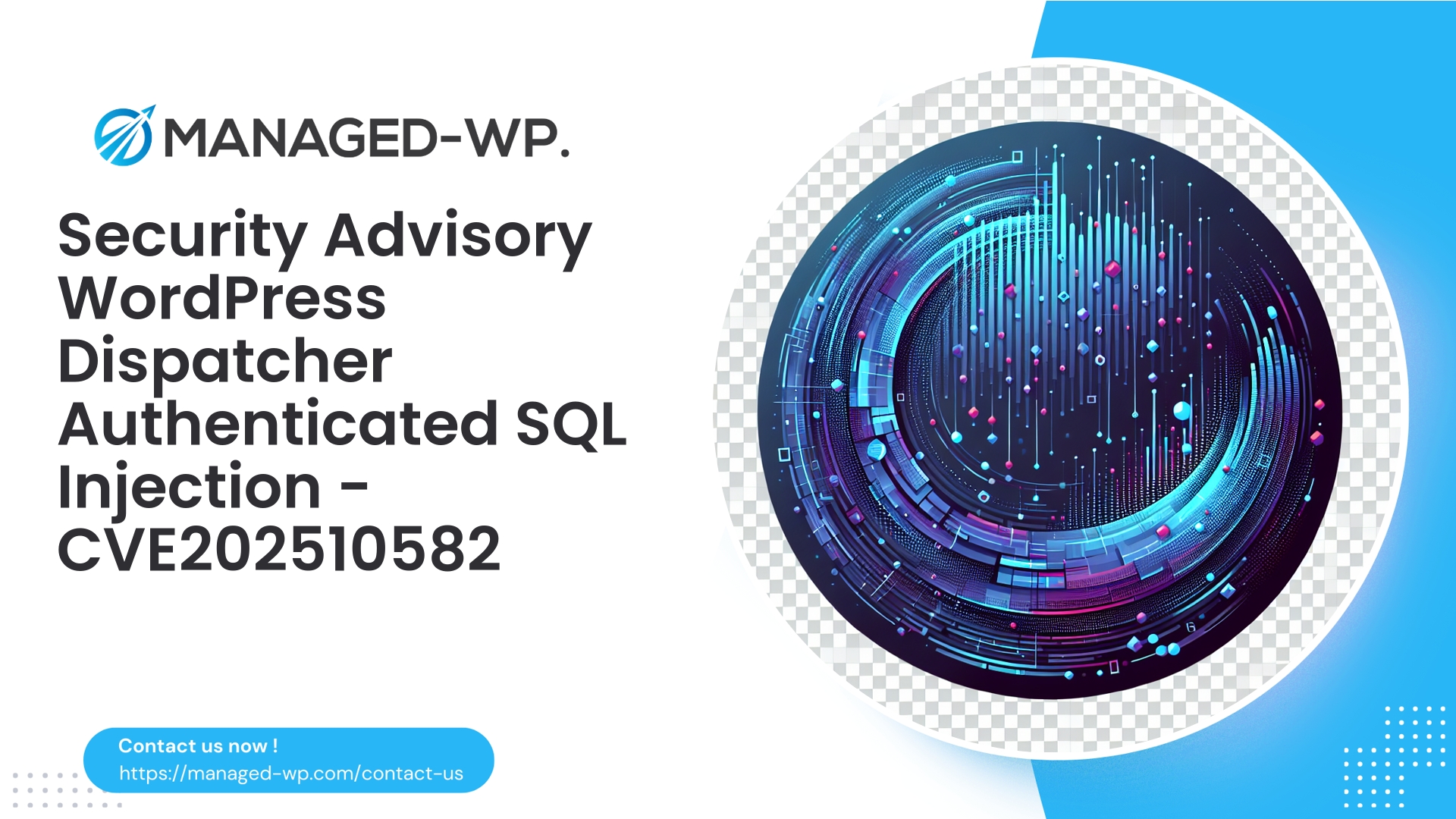| Plugin Name | WP Dispatcher |
|---|---|
| Type of Vulnerability | Authenticated file upload vulnerability |
| CVE Number | CVE-2025-9212 |
| Urgency | Critical |
| CVE Publish Date | 2025-10-03 |
| Source URL | CVE-2025-9212 |
URGENT: WP Dispatcher (<=1.2.0) — Authenticated Subscriber Arbitrary File Upload (CVE-2025-9212) — Immediate Actions You Must Take
Expert guidance from Managed-WP, your trusted US-based WordPress security team, on the critical WP Dispatcher file upload vulnerability. Learn how to contain the risk, detect exploitation, recover, and safeguard your site — including how Managed-WP offers proactive protection while you remediate.
Author: Managed-WP Security Experts
Summary: A severe arbitrary file upload vulnerability has been discovered in the WP Dispatcher plugin (all versions ≤ 1.2.0), tracked as CVE-2025-9212. This flaw allows any authenticated user with the Subscriber role — the lowest privilege level on WordPress sites — to upload malicious files, potentially leading to full site takeover via remote code execution. This post breaks down what you need to know, what immediate steps to take, how to detect and remediate, and how Managed-WP’s services protect you throughout this crisis.
Background — What Was Disclosed
On October 3, 2025, security researchers publicly disclosed a critical vulnerability impacting the WP Dispatcher plugin versions 1.2.0 and earlier. An authenticated user with Subscriber rights can exploit a poorly guarded plugin endpoint to upload arbitrary files without proper validation or access controls.
Why this matters: Subscribers are the default user role assigned to new registrants on many WordPress sites, especially membership or community-driven platforms. Attackers do not need administrator access — simply having or creating a Subscriber account is enough to exploit this issue.
Because arbitrary file uploads can place backdoors or web shells on your server — often in writable directories like /wp-content/uploads — this vulnerability effectively opens a backdoor for attackers to run malicious code and potentially seize full control. The published CVSS score is an alarming 9.9 (critical).
Who Is At Risk?
- Sites running WP Dispatcher plugin version 1.2.0 or older.
- Sites that allow user registrations or maintain Subscriber (or other low-privilege) accounts.
- Sites with writable uploads directories where PHP execution is permitted (default practice on many hosting providers).
- Sites lacking a Web Application Firewall (WAF), runtime protections, or proactive malware scanning and virtual patching.
If your environment matches these criteria, you are facing an acute security threat that demands immediate attention.
Immediate Actions (First 1-2 Hours)
Treat this as a security incident and prioritize containment. Your goal is to block exploitation attempts and check for evidence of compromise.
- Identify all affected sites
– Use your site management tools or wp-cli to locate boxes running WP Dispatcher ≤ 1.2.0:wp plugin list --format=csv | grep wp-dispatcher -n
- Temporarily disable the plugin
– If updating immediately is not possible, deactivate WP Dispatcher to stop further exploitation:wp plugin deactivate wp-dispatcher --allow-root
– Use the WordPress Admin Dashboard or SFTP file rename if wp-cli is unavailable.
- Block external access to vulnerable plugin endpoints
– If you have a WAF, create a custom rule to block or restrict POST/PUT requests to the plugin’s upload endpoint from non-admin IPs.
– Without a WAF, implement server-level rules to deny access temporarily. - Disable new user registrations
– Prevent attackers from creating new Subscriber accounts:wp option update users_can_register 0
– Or uncheck “Anyone can register” in Settings → General.
- Enforce password resets for low-privilege users
– Force password changes for all Subscribers to disrupt potential ongoing exploitation.
– Review and remove suspicious new accounts created recently. - Increase logging and monitoring
– Preserve all relevant logs and start near-real-time monitoring for signs of exploit attempts, like unusual POST requests targeting plugin endpoints.
Short-Term Containment (Next 1-3 Days)
These steps help detect possible breaches and reduce exposure.
- Search for malicious uploads
– Check for unusual PHP files in writable directories, especially uploads:find /path/to/wp-content/uploads -type f -iname '*.php' -mtime -30 -ls find /path/to/wordpress -type f -name '*.php' -exec grep -I --line-number -E "eval\\(|base64_decode\\(|shell_exec\\(|passthru\\(|system\\(" {} \; - Run malware scans
– Use trusted server-side and WordPress malware scanners to identify infected or suspicious files. - Audit file integrity
– Verify WordPress core and plugin files against known good versions:wp core verify-checksums wp plugin verify-checksums wp-dispatcher
- Lock down uploads directory
– Prevent PHP execution in uploads by adding server rules:
– Apache example (.htaccess):<FilesMatch "\.php$"> Deny from all </FilesMatch>
– For Nginx, implement a location block that denies PHP execution under
/wp-content/uploads. - Rotate credentials and security keys
– Reset admin and privileged user passwords.
– Change database passwords and rotate WordPress salts, which you can generate here. - Restore from clean backups if compromise is confirmed
– After confirming a breach, restore your site from a clean backup and follow recovery protocols before reconnecting to the internet.
Detection: Signs You May Have Been Exploited
Attackers usually upload web shells or backdoors. Watch for these:
- Unexpected PHP files in upload or plugin/theme folders.
- Unauthorized scheduled tasks (wp-cron jobs) executing code.
- New administrator accounts or privilege escalations.
- Suspicious outbound network activity (“beaconing”).
- Unexplained CPU or network spikes targeting obscure URLs.
- File modification times not aligning with maintenance schedules.
Helpful commands:
find wp-content/uploads -type f -iname '*.php' -mtime -7 -ls ls -la wp-content/uploads | grep -E '(\.php|\.phtml|\.php5|\.phar)' wp user list --role=subscriber --format=csv
Keep suspicious files offline for forensic analysis; avoid immediate deletion until evidence is collected.
Remediation and Recovery Steps
- Isolate impacted sites
– Take the site offline or enable maintenance mode to prevent further damage.
– Change hosting credentials and SSH keys if applicable. - Remove malicious files and backdoors
– Eradicate identified web shells and unauthorized PHP files. Engage security professionals if unsure. - Reinstall WordPress core, plugin, and themes
– Use fresh, verified copies from official repositories.
– Reinstall WP Dispatcher only once a vendor patch is available and tested. - Clean and audit database
– Inspect for injected malicious payloads or rogue scheduled tasks. - Harden access controls
– Reset admin passwords, implement 2FA, and restrict plugin/theme installation capabilities. - Restore backups when cleanup is insufficient
– For deeply infected sites, restoring from known clean snapshots often provides the safest path. - Continue post-recovery monitoring
– Maintain logging and scans for at least 30 days post-recovery to detect residual threats.
Long-Term Hardening Recommendations
Addressing this vulnerability requires a layered defense strategy:
- Enforce least privilege: Limit user registrations and minimize permissions for new users.
- Plugin management: Maintain an approved plugin list and avoid unmaintained or insecure plugins.
- Secure file uploads: Validate MIME types server-side, disable PHP execution in upload folders, and use randomized file naming.
- Server hardening: Restrict PHP execution and use secure file permissions.
- Continuous monitoring & FIM: Monitor file changes and suspicious traffic continuously.
- Virtual patching: Deploy a WAF with dynamic rules to block exploits before patches become available.
- Security testing and preparedness: Conduct regular penetration tests and maintain an incident response plan.
Recommended Server and WAF Protections
While waiting on vendor mitigation, consider these conceptual rules. Tailor to your infrastructure and test extensively:
- Block or throttle POST requests to vulnerable upload endpoints, allowing only trusted admin IPs.
- Reject suspicious content types (e.g., application/x-php) on uploads.
- Enforce WordPress nonce and capability validation where possible.
- Deny uploads of executable file types (.php, .phtml, .phar, etc.).
- Inspect request bodies for PHP tags or obfuscation patterns and block accordingly.
- Implement geo/IP restrictions for user registrations if applicable.
Note: Overly aggressive rules can break functionality; employ “block and report” modes during testing.
Forensic Evidence Collection
If you suspect exploitation, immediately collect:
- Webserver and PHP error logs
- Snapshots of the WordPress installation, plugin folders, and uploads
- Database export
- Memory and process dumps (for advanced investigations)
- Relevant timestamps, user IDs, IP addresses, and POST payloads
Preserving evidence prior to remediation is critical for thorough investigations.
Sample Investigation Commands
find wp-content/uploads -type f -iname '*.php' -exec ls -l {} \;
find . -type f -mtime -30 -printf '%TY-%Tm-%Td %TT %p
' | sort -r
grep -RIl --exclude-dir=wp-content/themes --exclude-dir=wp-content/plugins -E "(eval\(|base64_decode\(|gzinflate\(|preg_replace\(.*/e.*\()" .
Communications and Disclosure Guidance
Site owners should notify users calmly and clearly:
- Outline the vulnerability and risks without causing undue panic.
- Explain immediate actions taken (disabling plugin, monitoring).
- Describe next steps and anticipated timelines.
- Advise on recommended user actions (e.g., password resets).
Hosting providers managing multiple clients must coordinate messaging and offer remediation support.
How Managed-WP Protects Your Site Against Vulnerabilities Like This
As your US-based WordPress security partner, Managed-WP offers a multi-layered defense approach:
- Managed WAF Rules: We quickly develop and push targeted WAF signatures that block exploit attempts targeting vulnerable endpoints — including uploads restricted to Subscriber accounts. Deployments happen network-wide to shield you immediately, even before patches release.
- Continuous Monitoring and Malware Scanning: Our scanners flag suspicious PHP files and malicious patterns in your uploads and plugin directories.
- Virtual Patching: Our WAF prevents exploit payloads from reaching vulnerable code paths when vendors have not yet issued fixes.
- Incident Response Guidance: We provide expert, actionable remediation steps and automated triage tools.
- Low False Positives: Our rules prioritize site stability, especially for complex environments with user uploads.
If you’re already protected by Managed-WP, our safeguards have likely mitigated exploit attempts around this vulnerability. If not, implementing these immediate recommendations alongside Managed-WP’s WAF and scanning services is your best defense.
Secure Your Site Today With Managed-WP’s Free Protection Plan
Protect While You Patch — Managed-WP Basic (Free)
We understand the urgency and provide essential security at no cost to you until vendor patches become available:
- Managed WAF with real-time rule updates
- Malware scanning with scheduled automated reviews
- Virtual patching against top WordPress vulnerabilities
- Unlimited bandwidth and no throttling on security operations
Sign up instantly to activate free, expert-managed protection: https://manage.wp-firewall.com/free-plan
For multi-site environments, upgrading to our Standard or Pro plans adds automated malware removal, custom IP blocklists, monthly security reports, and premium virtual patching options.
Common Questions Addressed
Q: “What if I can’t disable the plugin immediately?”
A: Implement a WAF rule blocking the plugin’s upload endpoints for all non-admin users. Additionally, disable new user registration and monitor logs closely.
Q: “Should I delete all Subscriber user accounts?”
A: Not necessarily. Review accounts carefully and remove suspicious or unfamiliar ones. Enforce password resets for all low-privilege users where practical.
Q: “Is blocking PHP execution in uploads safe?”
A: In most cases, yes. Uploads rarely require executable PHP files. If your site relies on this functionality, thoroughly test this control in a staging environment first.
If You’ve Already Been Hacked — Critical Next Steps
- Isolate the compromised site immediately.
- Preserve all logs and forensic evidence.
- Identify and remove all backdoors and malicious files.
- Rotate all credentials (WordPress, database, SSH, API keys).
- Search for persistence mechanisms: rogue cron jobs, admin accounts, modified files.
- Reinstall core WordPress, plugins, and themes from verified sources.
- Apply security hardening and restore site functionality cautiously.
- Engage professional incident response if deeper compromise is suspected.
Final Recommendations & Checklist
- Inventory all WP Dispatcher installations ≤ 1.2.0 immediately.
- Deactivate the vulnerable plugin or block endpoints via WAF.
- Disable user registration if not required temporarily.
- Scan for malicious PHP files, especially in uploads.
- Lock down upload directories against PHP execution.
- Reset credentials and rotate all WordPress salts.
- Restore from clean backups if you detect compromise.
- Enroll in Managed-WP protection to maintain virtual patching and monitoring.
- Keep detailed logs and continuous monitoring active.
Closing Expert Insights From Managed-WP
Arbitrary file upload vulnerabilities pose one of the gravest risks to WordPress sites, opening doors to remote code execution even from minimal permissions. This vulnerability’s combination of low-privilege abuse and writable upload directories demands swift, decisive action.
A layered security model—incorporating rapid containment, thorough detection, virtual patching, and rigorous remediation—is the only way to safeguard your site and data effectively. Whether managing a single website or hundreds, make patch implementation and managed WAF protection integral parts of your security protocol.
For specialized assistance with triage, virtual patching, or post-incident hardening, our US-based technical team at Managed-WP stands ready to support your needs.
Stay vigilant, act decisively, and treat all disclosures as security incidents until your environment is fully verified clean.
— Managed-WP Security Experts



















